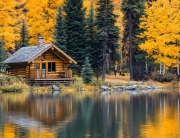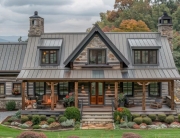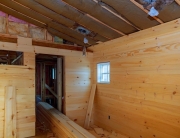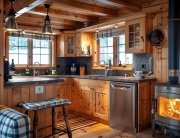Log homes are generally not hard to sell because they often appeal to a specific niche market. These buyers value their unique aesthetic, character, and rustic atmosphere. Log homes and cabins have limited availability in most areas and can sometimes sell faster than conventional homes, duplexes, or condominiums.
Log Homes and cabins can potentially command a higher price per square foot. Keep in mind that finding the right buyer and properly marketing the home or cabin is crucial due to their specialized nature and location.
Why We Like Log Home
Americans like log homes for many aesthetic and practical reasons. Studies show that living in them can help change your lifestyle while becoming mentally and physically healthier. They are built with sustainable materials, strong, and durable against the elements for generations to come. Log homes provide a calmer environment and help families bond together better than conventional homes. Log homes are an American icon.
- Log homes can change your lifestyle for the better because they provide a sense of calmness and relaxation.
- They are cool to live in and owners enjoy coming home for the day.
- Log homes tend to foster a love of nature and outdoor living.
- Natural building materials reduce the off-gassing created by manmade materials.
- Log homes provide a natural knack for air purification.
- They absorb excess humidity and release it slowly.
- Logs and log siding are sustainable building materials.
Many homeowners say that living in a log home is downright good for your family and pets. It’s like being on vacation every day.
Structural Benefits Of Log Homes
 Log homes not only provide mental and emotional benefits for their occupants, they have some significant efficiency benefits you will enjoy, such as:
Log homes not only provide mental and emotional benefits for their occupants, they have some significant efficiency benefits you will enjoy, such as:
- Log homes are durable and withstand the elements well in any climate. There are some homes that are more than 300 years old and are still occupied. Their construction is sturdy and has high structural integrity.
- Thicker walls provide more insulating qualities that reduce heating and cooling bills. Wood stores the sun’s heat during the day and releases it during the night to help keep the home warmer in the winter.
- Thicker walls mean more noise-dampening qualities than thin drywall and siding. This is helpful when a log cabin is built near noisy streets or county roads. The solid mass of log siding or full logs and their shapes deflect noise better than flat walls.
“Log homes are generally not hard to sell because they often appeal to a specific niche market. They can potentially command a higher price per square foot.”
Key Points About Selling Log Homes
There are some key points to remember about selling log homes and cabins. Understanding them will put you in a better position to sell yours, including:
- Limited Supply – Fewer log homes are built compared to traditional homes. This can provide a smaller pool of comparable properties on the market that can increase their market value.
- Location Matters – The resale value of a log home is significantly impacted by its location. Those built in scenic areas like mountains and lakeside properties are especially desirable. When building a log home choose a strategic location.
- Niche Appeal – Log homes attract buyers who love the rustic and natural feel which can create a strong demand in certain regions.
- Proper Marketing – To sell a log home effectively, it’s important to highlight its unique features. Use target marketing strategies to reach potential buyers who appreciate this style of home living.
Overcoming Potential Challenges To Selling Log Homes
 Make it easier for appraisers and lenders to accurately value your log home or cabin by avoiding an awkward design or floor plan. Homes that more people can relate to will increase your chances of selling. Unusual homes make it harder to appraise because there will be limited to no comparable properties to establish values.
Make it easier for appraisers and lenders to accurately value your log home or cabin by avoiding an awkward design or floor plan. Homes that more people can relate to will increase your chances of selling. Unusual homes make it harder to appraise because there will be limited to no comparable properties to establish values.
Keep your log home maintained to increase your chances of selling it. Properly stain and seal the log siding or full logs when it is first built. Maintain the logs according to the stain and sealant manufacturer’s recommendation. If you can’t do this yourself, hire a professional. Keep in mind that although log homes are appealing to specific groups, the potential pool of buyers can be smaller compared to conventional homes. When it’s time to sell, use a realtor with experience selling log homes.
The Future Of Log Homes
More than 35,000 log homes are built in the U.S. each year which attests to their popularity. Log homes make up about 10% of the custom home-building market in America. As the demand for log homes grows, current homeowners should have higher chances of selling theirs.







Recent Comments